Welcome back to your favorite baking and dessert blog!
You will not be going back to making basic white bread after making this Japanese Shokupan (Milk Bread using Tangzhong). Also called the Japanese Hokkaido milk bread, this light and fluffy Japanese milk bread uses the Tangzhong method, which was popularized by Yvonne Chen in her book 65º C Bread Doctor. For a better understanding, head to the ingredient section to learn more about tangzhong.
You can use this method to make any bread fluffier like use it to make these mini buns even softer.
As always, I will describe in detail the how and why of fluffy Japanese milk bread so that you will not have any questions or doubts after reading this post. If you don’t have time, I suggest just clicking on the recipe card immediately.
Let me clear out some terminology doubts right away first,
Tangzhong: Tangzhong, or the roux method, was popularised by Yvonne Chen. In this method, flour and water are taken in a ratio of 1:5 and cooked till sticky.
Shokupan: Means eating bread in Japanese, and it is milk bread.
Hokkaido milk bread: This is a milk bread coming from the Hokkaido region of Japan. It’s a soft cotton bread.
Table of contents:
- Equipment required
- Ingredients required
- Procedure
- Step-by-step picture
- Video Tutorial
- FAQ
- Recommended recipes
- Recipe Card
There are links on this site that can be defined as affiliate links. As an Amazon Associate, I earn from qualifying purchases.
What equipment do I need to make Japanese Shokupan?
A set of teaspoons and tablespoons:
This stainless steel measuring spoon set is perfect. I use the one that my pastry college provided to me. I did use the plastic ones, but let me tell you, they may look boring, stainless steel is best for long-term and safe use.
Big Bowl:
I use a big bowl because it reflects the light when I shoot videos, and you also get to see all the ingredients. It can also be used in the microwave.
Chopping board:
I bought my chopping board from a fair in Shantiniketan, but I found something similar online.
Weighing Scale:
Not everything good is costly, weighing scale is perfect for weighing for all your recipes. I have been using this one for 6 years, and then it broke because I dropped it by mistake. You would think I bought one after that, but no. I decided to use a tape and kept using it for 6 more months until it finally gave up, and I had to buy another one.
Bread loaf Tin
Serrated bread knife
Spatula:
Trust me when I say, you need silicon spatula. It’s the best thing ever! Nothing, I repeat, nothing can clean your bowls the way a spatula cleans it. Also, bonus points, it’s heat resistant, dishwasher safe, and has no cracks and crevices, so it’s easy to clean.
Balloon Whisk:
This balloon whisk has a good grip and rounded tip for better whisking. I don’t use this because I already got balloon whisks when I got my toolkit from college, but this one’s a good whisk.
Pastry brush
for milk wash. You want to avoid using a wooden brush oven here. Why? Because your bread is proofed and happy, you don’t want to use a rough pastry brush and punch a hole in there! This brush will be gentle on the dough and get the job done.
Dough scraper
for portioning dough. This is essential while making bread. The one that I use is from my college days, so as you can see, it really is a one-time investment. I am linking this one over here because it is stainless steel, so the chances of it getting bent are very low. Use it to clean your hands and table while making the dough, cut out portions of dough, lift the dough, and even shape high-hydration dough.
What ingredients do I need to make Japanese Shokupan?
All Purpose Flour
Let me tell you this, you can get beautiful bread using all-purpose flour, too. That being said, you can use bread flour, too, to get even better results. I used regular AP flour to make this bread, and it gave me a beautiful, light, and fluffy Japanese milk bread.
Yeast
I am using active dry yeast in this recipe. If you have instant yeast, use half the amount for this recipe. Instant yeast does not require any activation. This ingredient is important in giving bread its classic flavor and rise.
Sugar
You can use grain sugar or castor sugar. The sugar is food for the yeast, which helps in adding flavor. Sugar is also responsible for adding color to the bread.
Milk
Milk is used to make the bread a little richer in taste and contributes to the color, too. The fat present in milk makes the texture of the bread softer.
Salt
Imagine if your bread kept rising and finally burst, fun? Not much when you want to have bread. Salt is what controls the fermentation of yeast, and it also makes the gluten strands stronger.
Butter
Butter is mostly butterfat; hence, using this makes the dough soft and gives it a richer taste.
Water
Water helps in dissolving all the ingredients and helps in making the dough by creating gluten.
Tangzhong
Tangzhong, or the roux method, was popularised by Yvonne Chen. In this method, flour and water are taken in a ratio of 1:5 and cooked till sticky. Let me explain what is happening. 80% of the flour is starch, and this starch forms a gel when it absorbs water. This is called gelatinization, this is why cornstarch slurry is added, and it makes the gravies and curries thick because the starch absorbs water and becomes a gel. Now, when this starch when heated, its capacity to absorb water increases even more. This is why, to make tangzhong, we take 5 times more water than the flour, which the flour absorbs readily and forms a sticky mix. This mix, although a small amount, now has five times more moisture. Now, when you add this excess moisture to the dough, what it does is make the bread soft and fluffy!
Flour
The flour will absorb the moisture and create the base of the tangzhong.
Water
You will be taking the flour and water in a ratio of 1:5. There is another method called the Yudane method, but I will explain that in the FAQ section. The water is what will make the bread soft when tangzhong is used.
Check the recipe card for the quantity.
How to make Japanese Shokupan (Milk Bread using Tangzhong)?
Making the tangzhong
Begin by making the tangzhong. In a saucepan, add the flour and water and cook it on a medium flame. Keep stirring continuously till the tangzhong becomes thick and the flour has absorbed the water completely. It will look similar to thick cornflour slurry.
Pre-prep
Sieve the flour and salt in a bowl. Keep aside some milk for brushing on the bread before baking.
Activating the yeast
If you are using instant yeast, skip this step. If you are using active dry yeast like me, then in another cup or bowl, mix the yeast, milk, and sugar. Stir to mix well and dissolve the sugar. Cover and let the yeast activate for 5 to 10 minutes.
If you don’t have yeast, no worries, make this no-yeast bread, and come back to this recipe later.
Here, the yeast is feeding on the sugar to create carbon dioxide and alcohol. You can see the carbon dioxide in the form of bubbles in the mix, and you can smell the alcohol.
Making the dough
Once the yeast mix is bubbly and frothy, add the tangzhong to it. If it is not bubbly, please check the expiry date. If you have doubts about whether your yeast is active or not, you can give this post a read. In case it has expired, you can read this post on what to do with expired yeast.
Start kneading the dough. This recipe is a small batch of dough that can be easily kneaded by hand or kneaded in a machine using the dough hook. If using the machine, do not knead for more than 6-8 minutes. By hand, it will take a little longer, like 15 minutes. My hands start paining, so I let the dough rest for 15 minutes in between and continue kneading. The rest allows the gluten to relax and stretch, resulting in a dough that is easier to handle.
Add the butter after the dough has come together.
Knead it to form a small, smooth, round ball or “boule.”
If you are confused about whether your bread has been kneaded enough or not, you can go ahead and give this post a read: 7 signs your bread dough is kneaded enough.
Bulk fermentation
Brush some oil in a bowl and place the dough inside. This is to prevent the dough from sticking to the bowl.
Cover the dough with either a damp cloth or a cling film and let it proof in a warm area.
If it is too cold where you are staying, pre-heat your oven for about 5 minutes at 200 degrees Celsius/392 degrees Fahrenheit, and then place the dough bowl inside. Place a cup of water to create some humidity inside, too.
Let it rest for an hour.
I have been baking bread for years now, so I can tell by looking at the dough that the first rise is done. If you are not sure that the first rise or the bulk fermentation is done, you can read this post: How to tell when the first rise is done?
Shaping
Punch to degas the dough, I know, satisfying! You degas to release the excess amount of gas that has been created in the dough.
If you have a weighing scale [read you should], measure out 126 grams of portions of the dough. In case you don’t have a weighing scale, simply eyeball and divide the dough into 3 parts.
Now roll up the dough into cute little roundels, and punch the roundels down into a rectangular shape. Fold the dough from two sides towards the center. Roll the dough from one end to the other. Refer to the pictures to shape it well. Seal the edges well.
Place it on a greased bread loaf tin. Grease using butter or oil. Place the three rolls side by side.
Just make sure it has enough space for the shokupan to double up in size.
Proofing
Cover the dough with either a damp cloth or a cling film and let it proof in a warm area.
Let it rise for half an hour or till it doubles up in volume. Check for proofing by poking the bread lightly, and it should create a dent that would spring back slowly till halfway.
Preheat the oven to 200 degrees Celsius/392 degrees Fahrenheit.
To know more about bread proofing, read this post: How to tell if bread is proofed perfectly?
Baking it in the oven
Prepare a milk wash by mixing 50 ml of milk with a pinch of salt and sugar.
Gently apply milk wash using a pastry brush. This step makes the bread loaf more golden in color.
Bake your bread at 200 degrees Celsius/392 degrees Fahrenheit for 18-20 minutes. Every oven is different, so check it at 15 minutes. In the oven, the proteins and sugars that are in the dough, with the combination of heat from the oven, brown. This is called the “Maillard reaction” and is what makes the buns so visually appealing.
After bake care
Brush it with some oil or butter immediately after taking it out of the oven. This keeps the shokupan soft.
Once they have cooled down, store it in an airtight container. It will stay good for up to 5 days.
To use, slice and reheat the bread on a pan or in the microwave.
The tangzhong milk bread recipe is done! You now have freshly baked light and fluffy Japanese milk bread or shokupan. Slice and enjoy!
Frequently Asked Questions about Making Japanese Shokupan:
What is shokupan in Japanese?
It means eating bread in Japanese, and it is milk bread.
How to know when the tangzhong is done cooking?
The tangzhong is done cooking when it reaches a thick, pudding-like consistency and leaves visible lines or streaks when stirred after absorbing all the moisture.
Is shokupan the same as milk bread?
Yes, shokupan is a type of milk bread characterized by its soft and fluffy texture.
Why is shokupan so expensive?
The price of shokupan can vary based on factors like ingredients, production methods, and brand reputation. Higher-quality ingredients and specialized techniques can contribute to its higher cost.
What does Japanese milk bread taste like?
It tastes like rich yet fluffy and soft white bread. It will be mildly sweet.
Why is Japanese bread so soft?
Japanese bread, including shokupan, often incorporates tangzhong or yudane methods that involve pre-cooking some of the dough. This process creates a unique, tender texture and enhances the softness.
Why is shokupan so good?
Shokupan’s popularity comes from its exceptional softness, lightness, and fluffy texture, making it enjoyable to eat on its own or as a base for sandwiches or toasts.
What to eat with Japanese shokupan?
Japanese shokupan can be enjoyed with various toppings such as butter, jam, and Nutella or used to make sandwiches, French toast, or bread pudding.
How long does Shokupan bread last?
Shokupan bread typically stays fresh for 5 days when stored properly in an airtight container or plastic bag at room temperature.
Who invented shokupan?
Shokupan’s origins are traced back to Japan, but it isn’t easy to attribute its invention to a specific individual. However, this light and fluffy Japanese milk bread uses the Tangzhong method, which was popularized by Yvonne Chen in her book 65º C Bread Doctor.
How to store Japanese shokupan?
Store Japanese shokupan in an airtight container or plastic bag at room temperature to maintain its freshness.
Can I freeze shokupan bread?
Yes, you can freeze shokupan bread. Slice it before freezing, and store the slices in an airtight container or freezer bag. Thaw individual slices as needed.
What is the Yudane method?
The Yudane method is a technique used in bread-making that involves mixing boiling water with a portion of the flour in the recipe to create a gel-like mixture. This pre-gelatinized mixture improves the bread’s texture and shelf life.
Is Japanese milk bread the same as white bread?
Japanese milk bread is a type of white bread that is distinguishable by its soft and fluffy texture, slightly sweet taste, and use of specific techniques like tangzhong or yudane methods.
More bread recipes that you may like:
[ CLICK ON THE IMAGE FOR THE RECIPE]
Japanese Shokupan (Milk Bread using Tangzhong)
You will not be going back to making basic white bread after making this Japanese Shokupan (Milk Bread using Tangzhong).
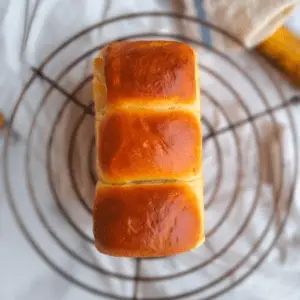
Ingredients
- Flour: 180 grams
- Yeast: 4 grams
- Sugar: 25 grams
- Milk: 60 ml
- Salt: 4 grams
- Butter: 50 grams
- Water: 20 ml
- Tangzhong
- Flour: 20 grams
- Water: 100 ml
- Milk wash:
- Milk: 50 ml
- Sugar: 1 tbsp
- Salt: a pinch
Directions
- Step 1 Begin by making the tangzhong.
- Step 2 In a saucepan, add the flour and water and cook it on a medium flame.
- Step 3 Keep stirring continuously till the tangzhong becomes thick and the flour has absorbed the water completely. It will look similar to thick cornflour slurry.
- Step 4 Sieve the flour and salt in a bowl.
- Step 5 If you are using instant yeast, skip this step. If you are using active dry yeast like me, then in another cup or bowl, mix the yeast, milk, and sugar. Stir to mix well and dissolve the sugar. Cover and let the yeast activate for 5 to 10 minutes.
- Step 6 Once the yeast mix is bubbly and frothy, add the tangzhong to it.
- Step 7 Start kneading the dough.
- Step 8 Add the butter after the dough has come together.
- Step 9 Knead it to form a small smooth round ball or “boule”.
- Step 10 Brush some oil in a bowl and place the dough inside. Cover the dough with either a damp cloth or a cling film and let it proof in a warm area.
- Step 11 Let it rest for an hour.
- Step 12 Punch to degas the dough,If you have a weighing scale, measure out 126 grams of portions of the dough. In case you don’t have a weighing scale, simply eyeball and divide the dough into 3 parts.
- Step 13 Now roll up the dough into little roundels, and punch the roundels down into a rectangular shape. Fold the dough from two sides towards the center. Roll the dough from one end to the other. Refer to the pictures to shape it well. Seal the edges well.
- Step 14 Place it on a greased bread loaf tin. Grease using butter or oil. Place the three rolls side by side. Just make sure it has enough space for the shokupan to double up in size.
- Step 15 Cover the dough with either a damp cloth or a cling film and let it proof in a warm area.
- Step 16 Let it rise for half an hour or till it doubles up in volume. Check for proofing by poking the bread lightly, it should create a dent that would spring back slowly till halfway.
- Step 17 Preheat the oven to 200 degrees Celsius/392 degrees Fahrenheit.
- Step 18 Prepare a milk wash by mixing 50 ml of milk with a pinch of salt and sugar. Gently apply milk wash using a pastry brush. This step makes the bread loaf more golden in color.
- Step 19 Bake your bread at 200 degrees Celsius/392 degrees Fahrenheit for 18-20 minutes. Every oven is different so check it at 15 minutes.
- Step 20 Brush it with some oil or butter immediately after taking it out of the oven. This keeps the shokupan soft.
- Step 21 Once they have cooled down, store it in an airtight container. It will stay good for up to 5 days.To use, slice and reheat the bread on a pan or in the microwave.
- Step 22 Enjoy!

MADE THIS RECIPE?
Tag @alishasdessertsafari on Instagram and hashtag it #alishasdessertsafari
Don’t forget to Subscribe to get exclusive well-curated value-packed mail every month that you wouldn’t want to miss out on!
I hope you found my post “Japanese Shokupan (Milk Bread using Tangzhong)” helpful. If you have any queries, feel free to post them in the comments below.
Thank You.


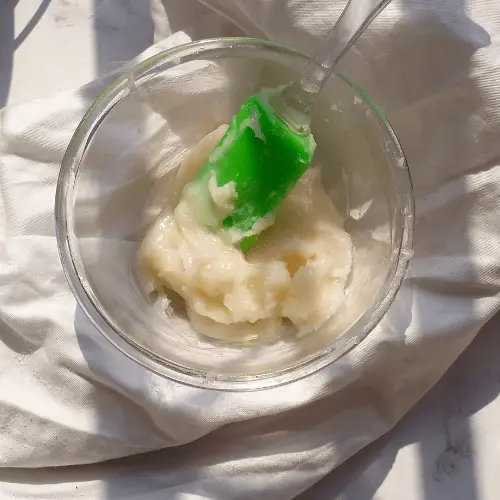
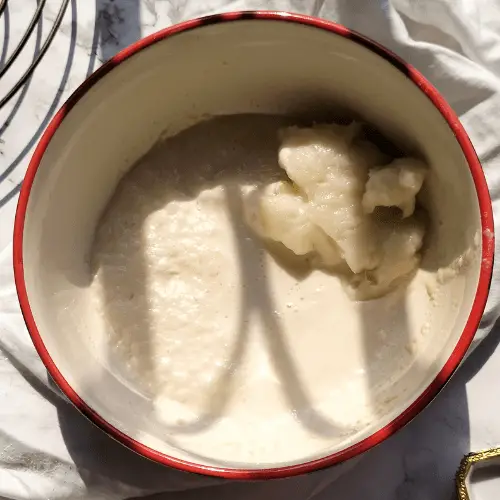

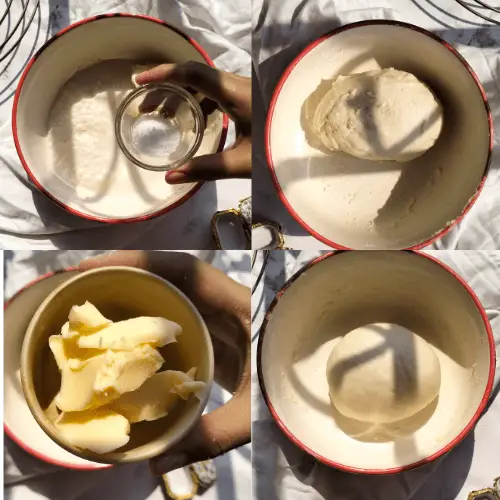

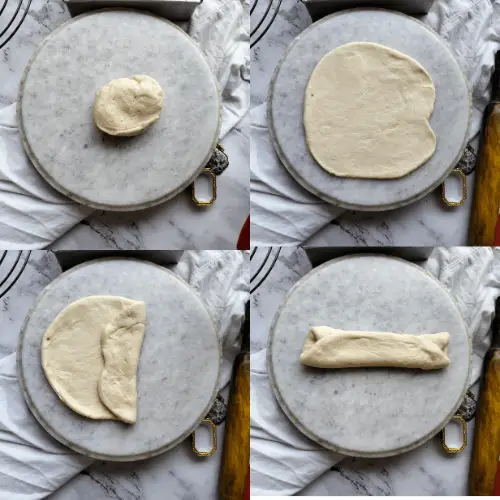
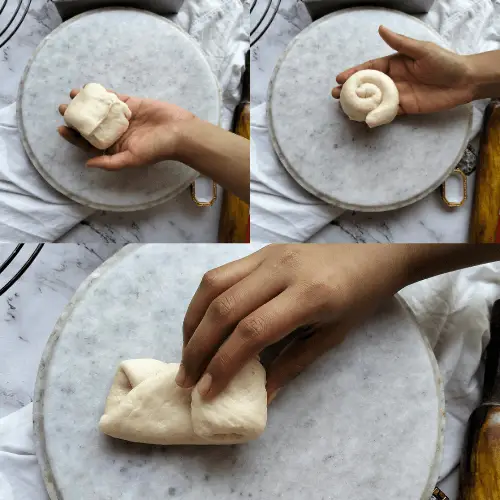
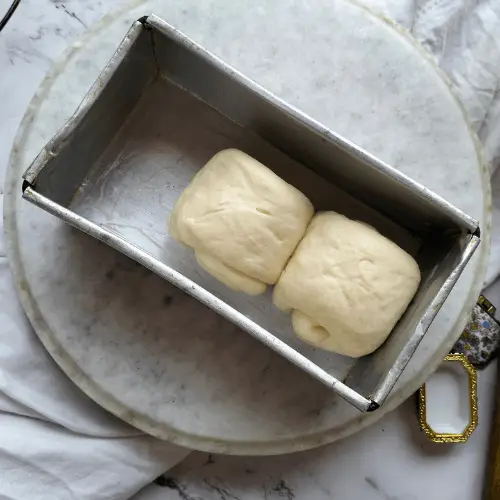
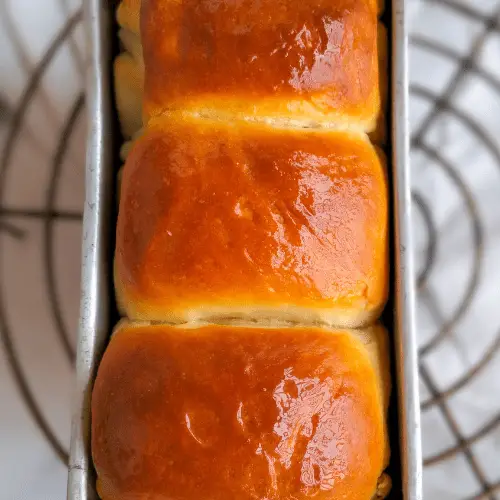
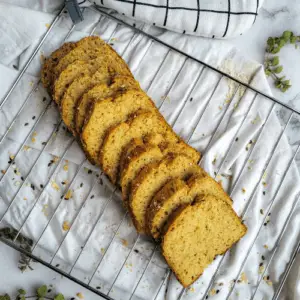
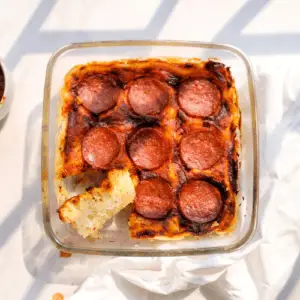
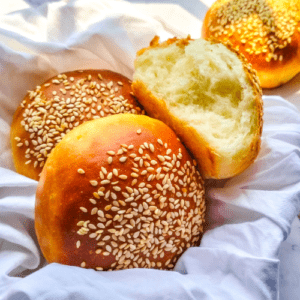


1 thought on “Japanese Shokupan (Milk Bread using Tangzhong)”